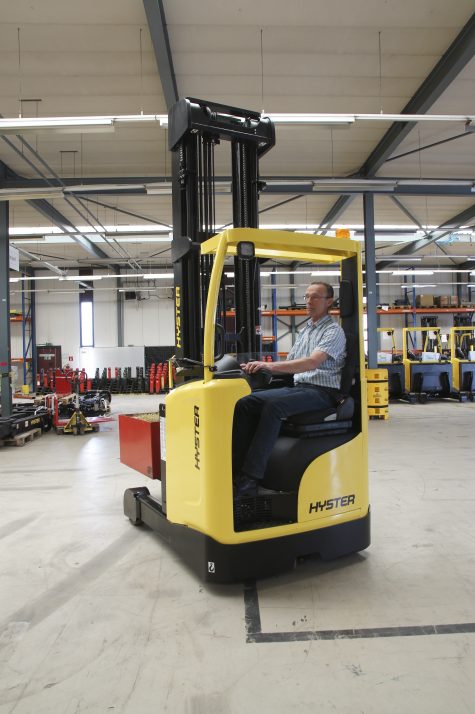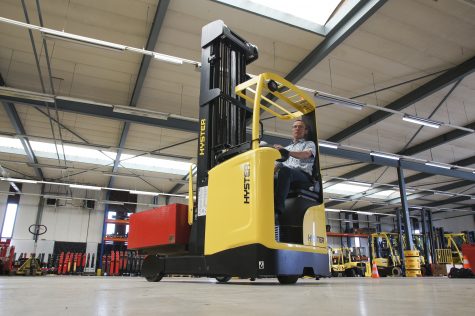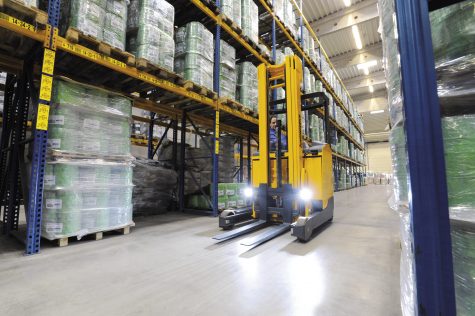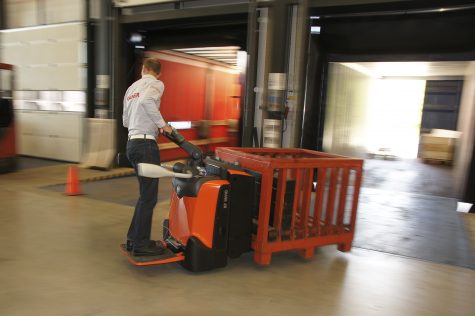Warehouse trucks – for example reach trucks – can achieve speeds of up to 15 km/h. But is such a pace safe and wise? What are the real consequences if you drive slower? Do you lose a lot of productivity, and what is the impact on energy consumption? A test on site will help to answer these questions.
A large logistics service provider recently asked these questions to their supplier of internal transport equipment. For safety reasons, the company wanted to fully switch to lower speeds in the warehouse and suggested a maximum driving speed limit of 10 or even 8 km/h. But how much would this decision affect warehouse performance? Safety nowadays requires more and more attention, but performance also remains important because, obviously, the logistics service is paid for by customers.
For a truly fair and objective answer the supplier turned to Andersom Testing. In consultation it was decided to conduct measurements for both reach trucks and pallet trucks with ride-on operator. Both trucks form the majority in this huge distribution centre. The current top speed setting for the reach trucks is 14 km/h and the pallet trucks are driving at 11 km/h.
The survey was conducted for the most common tasks for both trucks. The reach t rucks bring pallets from the goods receipt area (inbound) to the bulk storage, which has separate sections of block stacking and storage racks. The pallet trucks transport the pallets with collected orders from the collecting stations to the dispatch area (outbound). Both tasks have various transport distances and routes.
rucks bring pallets from the goods receipt area (inbound) to the bulk storage, which has separate sections of block stacking and storage racks. The pallet trucks transport the pallets with collected orders from the collecting stations to the dispatch area (outbound). Both tasks have various transport distances and routes.
Measurements of the reach trucks were conducted at five different driving distances and five different storage locations in the warehouse. In the measurements, the empty ride back to the starting location has also been included to complete the cycle. Thus, the driving distances per cycle come to 101 metres (shortest distance) and 472 metres (longest distance).
Within the different distances different sectors of the warehouse are achieved. Here, the reach truck driver passes several intersections and needs to drive both to the left and to the right in order to achieve the correct location. Almost nowhere is the distance between the intersections and exits longer than 50 metres. There is also other traffic in the area that could negatively influence the measurements. For a clear measurement this traffic must be avoided. This appeared – while testing – to be very difficult, so many measurements were therefore repeated several times to get a clear picture.
The reach truck performance was measured with four different speeds: 14, 12, 10 and 8 km/h. The standard lifting and acceleration speeds were hereby left unchanged. Earlier tests have shown that driving as fast as possible with all kinds of lifting trucks is only useful if the unobstructed roadway is at least 75 metres or more. If this distance is shorter, then the benefit from the higher speed almost completely disappears with the need to brake and accelerate again. A lifting truck usually uses about 20 metres to reach full speed and virtually every warehouse has unobstructed routes of 75 metres or more. It is therefore logical to choose a speed which is in the vicinity of the average speed. In all our measurements over the years, we have always arrived at an ideal speed of 11 km/h. Would that be the case in these measurements too?
Yes, even in this huge warehouse we arrive at an ideal driving speed of about 11 km/h for the reach truck. A company with the emphasis on productivity can set the driving speed up to 12 km/h. One that opts for additional safety might choose a driving speed of 10 km/h. It seems logical that 8 km/h would be even safer, but appearances can be deceiving. This driving speed is so low tha t there is a risk that the driver does not stay alert and would probably lose focus on correctly driving the truck.
t there is a risk that the driver does not stay alert and would probably lose focus on correctly driving the truck.
And what about the distances? At the shortest distances it also turns out that the differences in productivity are logically the smallest and basically negligible. We also conclude that driving at 10 km/h even over this short distance is 25% more efficient in terms of energy consumption.
The distance of 220 metres (including return trip) in this warehouse is considered the ‘average distance’. A driving speed of 12 km/h leads to a loss of 2.5% in productivity and energy savings of 21% compared to 14 km/h. At 10 km/h productivity falls by 9.2% and the energy gain is approximately 28%.
Depending on the traffic in the warehouse, the loss of slower driving i s smaller if we encounter more obstacles on the track…and that is usually the case in this warehouse. A company that wants optimum productivity should preferably use one-way lanes and minimise the number of obstacles in the warehouse. The additional detour metres typically provide far less loss of productivity than driving slowly or coming to a complete stop at obstacles. The overall safety benefits greatly from one-way traffic. If it is possible to drive/work double plays, then the influence of fast driving is even smaller and it even pays off to drive at 11 or 10 km/h.
s smaller if we encounter more obstacles on the track…and that is usually the case in this warehouse. A company that wants optimum productivity should preferably use one-way lanes and minimise the number of obstacles in the warehouse. The additional detour metres typically provide far less loss of productivity than driving slowly or coming to a complete stop at obstacles. The overall safety benefits greatly from one-way traffic. If it is possible to drive/work double plays, then the influence of fast driving is even smaller and it even pays off to drive at 11 or 10 km/h.
For a pallet truck with ride-on operator, the ideal driving speed is around 10 km/h. Regardless of the driving distance, the loss in productivity is marginal compared to driving
with the maximum travel speed. However driving at 8 km/h is only recommended for very short distances. Only over much longer distances do we see a clear decline in productivity (approximately 18%).
Pallet trucks always move more smoothly between the other traffic in the warehouse and accelerate faster than other lifting trucks. They alsomaintain their average speed b etter. A pallet truck with a driving speed of just 10 km/h moves effortlessly along with a reach truck that runs at 11 km/h. If the reach trucks are set at 10 km/h, it would be wise to set the pallet trucks at 9 or 9.5 km/h. Otherwise the pallet truck is constantly driving on the heels of the reach truck. The differences in energy consumption for pallet trucks are not as large as for the reach trucks, but even here the general rule applies: ‘Faster driving always consumes much more energy than the gains in productivity!’.
etter. A pallet truck with a driving speed of just 10 km/h moves effortlessly along with a reach truck that runs at 11 km/h. If the reach trucks are set at 10 km/h, it would be wise to set the pallet trucks at 9 or 9.5 km/h. Otherwise the pallet truck is constantly driving on the heels of the reach truck. The differences in energy consumption for pallet trucks are not as large as for the reach trucks, but even here the general rule applies: ‘Faster driving always consumes much more energy than the gains in productivity!’.
Tags:
Andersom test, Forklift test, Test
Tough guys With the RPL201H and KPL201, EP Equipmen...

Freedom of choice in order picking With the Linde N...

Stable powerhouse With the 6 to 8 tonnes ECB series...